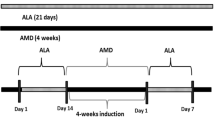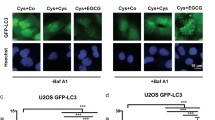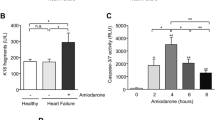Abstract
Amiodarone is an effective class III antiarrhythmic drug, however, the pulmonary toxicity is one of the most life-threatening complications of its use. The present study was designed to determine the mechanisms underlying pulmonary toxicity of amiodarone. In cultured human lung epithelial cells A549, amiodarone caused cell injury characterized by mitochondrial membrane depolarization, ATP depletion, enhanced propidium iodide (PI) uptake and increase in the number of Annexin-V positive cells, although the population of PI-stained cells appeared earlier and was not identical to that of Annexin-V stained cells, suggesting that the apoptosis and necrosis appeared in different cells. The apoptosis was accompanied with the activation of caspase-2, -3 and -8 but not caspase-9, and reversed by these caspase inhibitors. However, the caspase inhibitors had no influence on mitochondrial membrane potential or PI uptake after exposure of A549 cells to amiodarone. In contrast, mitochondrial cofactors such as L-carnitine and acetyl-l-carnitine attenuated mitochondrial membrane depolarization, abrogated cellular ATP depletion and reversed PI uptake without affecting Annexin-V positive cells. These finding suggest that different intracellular events operate to cause apoptosis and necrosis after exposure of pulmonary epithelial cells to amiodarone.








Similar content being viewed by others
References
Patterson E, Eller BT, Abrams GD, Vasiliades J, Lucchesi BR (1983) Ventricular fibrillation in a conscious canine preparation of sudden coronary death-prevention by short- and long-term amiodarone administration. Circulation 68:857–864
Flaker GC, Alpert MA, Webel RR, Ruder MA, Sanfelippo JF, Tsutakawa RK (1985) Amiodarone and sustained ventricular arrhythmias: statistical evidence of drug effectiveness. Am Heart J 110:371–376
Martin II WJ, Rosenow III EC (1988) Amiodarone pulmonary toxicity: recognition and pathogenesis. Part I Chest 93:1067–1075
Myers JL, Kennedy JI, Plump VJ (1987) Amiodarone lung: pathologic findings in clinically toxic patients. Hum Pathol 18:349–356
Pfisterer M, Kiowski W, Burckhardt D, Follath F, Burkhart F (1992) Beneficial effects of amiodarone on cardiac mortality in patients with asymptomatic complex ventricular arrhythmias after acute myocardial infarction and preserved but not impaired left ventricular function. Am J Cardiol 69:1399–1402
Ulrik CS, Backer V, Aldershvile J, Pietersen AH (1992) Serial pulmonary function tests in patients treated with low dose amiodarone. Am Heart J 123:1550–1554
Roca J, Heras M, Rodriguez-Roisin R, Magriñà J, Xaubet A, Sanz G (1992) Pulmonary complications after long term amiodarone treatment. Thorax 47:372–376
Jessurun GA, Boersma WG, Crijns HJ (1998) Amiodarone-induced pulmonary toxicity. Predisposing factors, clinical symptoms and treatment. Drug Safety 18:339–344
Ott MC, Khoor A, Leventhal JP, Paterick TE, Burger CD (2003) Pulmonary toxicity in patients receiving low-dose amiodarone. Chest 123:646–651
Reasor MJ, Kacew S (1996) An evaluation of possible mechanisms underlying amiodarone-induced pulmonary toxicity. Proc Soc Exp Biol Med 212:297–304
Wilson BD, Lippman ML (1990) Pulmonary accumulation of amiodarone and N-desethylamiodarone. Relationship to the development of pulmonary toxicity. Am Rev Respir Dis 141:1553–1558
Ohar JA, Jackson F, Dettenmeier PA, Bedrossian CW, Tricomi SM, Evans RG (1992) Bronchoalveolar lavage cell count and differential are not reliable indicators of amiodarone-induced pneumonitis. Chest 102:999–1004
Bolt MW, Card JW, Racz WJ, Brien JF, Massey TE (2001) Disruption of mitochondrial function and cellular ATP levels by amiodarone and N-desethylamiodarone in initiation of amiodarone-induced pulmonary cytotoxicity. J Pharmacol Exp Ther 298:1280–1289
Uhal BD, Wang R, Laukka J, Zhuang J, Soledad-Conrad V, Filippatos G (2003) Inhibition of amiodarone-induced lung fibrosis but not alveolitis by angiotensin system antagonists. Pharmacol Toxicol 92:81–87
Isobe I, Michikawa M, Yanagisawa K (1999) Enhancement of MTT, a tetrazolium salt, exocytosis by amyloid beta-protein and chloroquine in cultured rat astrocytes. Neurosci Lett 266:129–132
Yano T, Itoh Y, Sendo T, Kubota T, Oishi R (2003) Cyclic AMP reverses radiocontrast media-induced apoptosis in LLC-PK1 cells by activating A kinase/PI3 kinase. Kidney Int 64:2052–2063
Reers M, Smith TW, Chen LB (1991) J-aggregate formation of a carbocyanine as a quantitative fluorescent indicator of membrane potential. Biochemistry 30:4480–4486
Oka M, Itoh Y, Ukai Y (2000) Preferential inhibition by a novel Na+/Ca2+ channel blocker NS-7 of severe to mild hypoxic injury in rat cerebrocortical slices: A possible involvement of a highly voltage-dependent blockade of Ca(2+) channel. J Pharmacol Exp Ther 293:522–529
Bradford M (1976) A rapid and sensitive method for the quantitation of microgram quantities of protein utilizing the principle of protein-dye binding. Anal Biochem 72:248–254
Bargout R, Jankov A, Dincer E et al (2000) Amiodarone induces apoptosis of human and rat alveolar epithelial cells in vitro. Am J Physiol Lung Cell Mol Physiol 278:1039–1044
Card JW, Lalonde BR, Rafeiro E et al (1998) Amiodarone-induced disruption of hamster lung and liver mitochondrial function: lack of association with thiobarbituric acid-reactive substance production. Toxicol Lett 98:41–50
Szewczyk A, Wojtczak L (2002) Mitochondria as a pharmacological target. Pharmacol Rev 54:101–127
Brass EM (2000) Supplemental carnitine and exercise. Am J Clin Nutr 72:618–623
Gülçin I (2006) Antioxidant and antiradical activities of l-carnitine. Life Sci 78:803–811
Binienda Z, Przybyla-Zawislak B, Virmani A, Schmued L (2005) l-carnitine and neuroprotection in the animal model of mitochondrial dysfunction. Ann N Y Acad Sci 1053:174–182
Mazzio E, Yoon KJ, Soliman KF (2003) Acetyl-l-carnitine cytoprotection against 1-methyl-4-phenylpyridinium toxicity in neuroblastoma cells. Biochem Pharmacol 66:297–306
Dhitavat S, Ortiz D, Shea TB, Rivera ER (2002) Acetyl-l-carnitine protects against amyloid-beta neurotoxicity: roles of oxidative buffering and ATP levels. Neurochem Res 27:501–505
Martin EJ, Forkert PG (2004) Evidence that 1,1-dichloroethylene induces apoptotic cell death in murine liver. J Pharmacol Exp Ther 310:33–42
Itoh Y, Yano T, Sendo T et al (2006) Involvement of de novo ceramide synthesis in radiocontrast-induced renal tubular cell injury. Kidney Int 69:288–297
Kubota T, Yano T, Fujisaki K, Itoh Y, Oishi R (2005) Fenofibrate induces apoptotic injury in cultured human hepatocytes by inhibiting phosphorylation of Akt. Apoptosis 10:349–358
Baliga BC, Read SH, Kumar S (2004) The biochemical mechanism of caspase-2 activation. Cell Death Differ 11:1234–1241
Shin S, Lee Y, Kim W, Ko H, Choi H, Kim K (2005) Caspase-2 primes cancer cells for TRAIL-mediated apoptosis by processing procaspase-8. Embo J 24:3532–3542
Wagner KW, Engels IH, Deveraux QL (2004) Caspase-2 can function upstream of bid cleavage in the TRAIL apoptosis pathway. J Biol Chem 279:35047–35052
Chen H, Chung S, Sukumar S 2004 HOXA5-induced apoptosis in breast cancer cells is mediated by caspases 2 and 8. Mol Cell Biol 24:924–935
Seth R, Yang C, Kaushal V, Shah SV, Kaushal GP (2005) p53-dependent caspase-2 activation in mitochondrial release of apoptosis-inducing factor and its role in renal tubular epithelial cell injury. J Biol Chem 280:31230–31239
Yano T, Itoh Y, Matsuo M, Kawashiri T, Egashira N, Oishi R (2007) Involvement of both tumor necrosis factor-alpha-induced necrosis and p53-mediated caspase-dependent apoptosis in nephrotoxicity of cisplatin. Apoptosis 12:1901–1909
Author information
Authors and Affiliations
Corresponding author
Rights and permissions
About this article
Cite this article
Yano, T., Itoh, Y., Yamada, M. et al. Combined treatment with l-carnitine and a pan-caspase inhibitor effectively reverses amiodarone-induced injury in cultured human lung epithelial cells. Apoptosis 13, 543–552 (2008). https://doi.org/10.1007/s10495-008-0186-9
Received:
Accepted:
Published:
Issue Date:
DOI: https://doi.org/10.1007/s10495-008-0186-9




